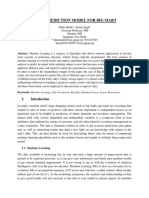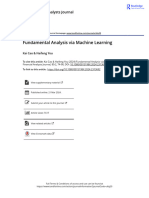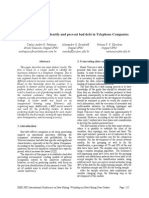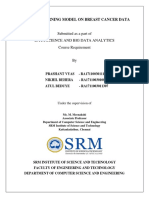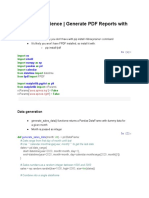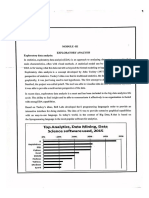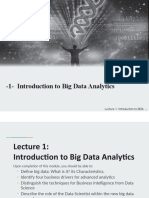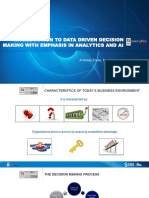Predictive Analytics Using Big Data: A Survey
Predictive Analytics Using Big Data: A Survey
Uploaded by
BESTJournalsCopyright:
Available Formats
Predictive Analytics Using Big Data: A Survey
Predictive Analytics Using Big Data: A Survey
Uploaded by
BESTJournalsOriginal Title
Copyright
Available Formats
Share this document
Did you find this document useful?
Is this content inappropriate?
Copyright:
Available Formats
Predictive Analytics Using Big Data: A Survey
Predictive Analytics Using Big Data: A Survey
Uploaded by
BESTJournalsCopyright:
Available Formats
BEST: International Journal of Management, Information
Technology and Engineering (BEST: IJMITE)
ISSN(Print):2348-0513; ISSN(Online): 2454-471X;
Vol. 3, Issue 9, Sep 2015, 61-68
BEST Journals
PREDICTIVE ANALYTICS USING BIG DATA: A SURVEY
G. KUMARESAN1 & P. RAJAKUMAR2
1
2
Research Scholar, Computer Science, St. Josephs College (Autonomous), Tiruchirappalli, Tamil Nadu, India
Assistant Professor, Computer Applications, Jeyaram College of Engineering, Tiruchirappalli, Tamil Nadu, India
ABSTRACT
Now-a-days, Information Technology is in the new era of Big Data, which provides more volume of data to
researchers and analysts. We have large-enough data in our hand, this available data have precious insight values that make
the administrators, policymakers and business analyst to take correct decision in right time. In order to find out the hidden
values from the existing data, we need some methods or techniques. Hence, Predictive analytics is an essential technique
while dealing with vital amount of potentially sensitive data. Here, based on perceived events, to predict the future
probabilities, trends and measures. With the help of existing data mining methods, in order to make predictions about
future events and recommendations. Predictive analytics is composed of various statistical and analytical methods used to
develop a new techniques to predict future possibilities. In the end, this research work discussed predictive analytics
various issues and challenges, available tools, applications and modeling techniques in big data.
KEYWORDS: Big Data, Predictive Analytics, Predictive Modeling, Learning Analytics, Educational Data Mining
INTRODUCTION
Big data is a term that is used to describe exponential growth and availability of data, both structured and
unstructured. As a promising term it contains the following characteristics: (i) Volume: The quantity of data generated.
(ii) Variety: The category to which the big data belongs. (iii) Velocity: The speed of generation of data. (iv) Variability:
The inconsistency which can be shown by the data. (v) Veracity: Accuracy of the data is based on the veracity of the
source data that is quality of the data. (vi) Complexity: Data management is becomes very complex when storing large
volumes of data from different sources. Big data analytics is the process of investigating big data to uncover hidden
patterns, unknown relations and some other useful information that can be used to make better decisions.
Today, most of the companies are store large volumes of diverse data (i.e. web logs, click streams, sensors, and
many other sources). The perceptions unknown within this big data hold tremendous business value. To handle the big
data challenges such as Volume, Variety, and Velocity a number of new technologies has been evolved. They are (i)
Apache Hadoop software is a cost-effective, massively-scalable platform for analysing big data. It can store and process
petabytes of data, including all the data types that dont fit into traditional RDBMS. (ii) Not only SQL (NoSQL) databases
relax the constraints of a traditional RDBMS to deliver higher performance and scalability. NoSQL databases can extend
the capabilities of Hadoop clusters by providing low-latency object retrieval or other DW-like functionality. (iii) Massively
parallel-processing (MPP) appliances extend the capabilities of RDBMS-based data warehouses. These systems can store
and process petabytes of structured data. (iv) In-Memory databases dramatically improve performance by eliminating most
of the data access latencies associated with shuttling data back and forth between storage systems and server processors.
In-Memory databases are available as an option on some of todays MPP appliances to provide real-time
Impact Factor(JCC): 0.9458- This article can be downloaded from www.bestjournals.in
62
G. Kumaresan & P. Rajakumar
performance for the most demanding applications. Predictive analytics is a branch of big data that deals with extracting
information from data and using it to predict trends and behaviour patterns. Predictive analytics applies innovative methods
such as, real-time regression analysis and machine learning analysis to predict future measures. It contains different view
approach like integrated reasoning, pattern recognition and predictive modeling. Many researchers have interest to building
an automated reasoning tool for identifying future events and measures.
Understand Data
Prepare Data
Business Goal
Model
Monitor
Deploy
Evaluate
Figure 1: Predictive Analytics Process
Figure 1 shows that the predictive analytics process must be continuous to ensure effectiveness and accuracy of
data prediction.
Related Work
Past years, predictive analytics can be applied in data mining for predicting future events especially in medical
sector, business, education, and crime detection. The health sector today contains bulk of hidden information that can be
significant in making powerful decisions. Abdelghani Bellaachia et al. proposed [3] predicting breast cancer lastingness
using data mining methods. The authors have examined three data mining methods such as Naive Bayes, propagated neural
networks and c4.5 decision tree algorithms. The first method is Naive Bayes method following Bayesian method, it is a
simple, clear and fast predictive method. Artificial neural networks is the second method, it is a multi-layer networks with
transmission is utilized. Finally, they uses c4.5 decision-tree algorithms. Overall, the authors study shows that the
preliminary results are promising prediction problem in medical datasets.
Rajeswari at al. proposed three datasets of different diseases such as Heart, Breast cancer and Diabetes disease
and tried to apply Feature Selection algorithm [5]. Feature selection is an important step in classification and also for
dimensionality reduction. Feature Selection is a preprocessing method is used to identify the significant attributes, which
play a dominant role in the task of classification. They analysed two different approaches for feature selection is done
especially for medical datasets. They also shows a novel approach for feature selection using correlation and by generating
association rules. The authors conclude that feature selection really helpful for dimensionality reduction and building cost
effective model for disease prediction in medical datasets.
Data mining is the correct technology to predict patterns in the health sector dataset. Though, it is very difficult to
predict some diseases like heart attack, as it is a complex job that needs more skill. Hlaudi Daniel Masethe et al. discussed
to predict heart disease using classification algorithms [4]. They applied some algorithms to predict heart attacks such as
j48, Naive Bayes, REPTREE and CART. The authors research work result shows that prediction accuracy is 99% and j48,
REPTREE and CART given a prediction model of 89 cases with a risk factor positive for heart attacks. This techniques
Index Copernicus Value: 3.0 - Articles can be sent to editor.bestjournals@gmail.com
Predictive Analytics Using Big Data: A Survey
63
strongly suggested that data mining algorithms are able to predict a diagnoses.
Huge amount of medical data that need powerful data analysis tools for processing. Data mining techniques can
also be used for diagnosis analysis which is very important but difficult task that would be performed accurately and
efficiently. Ramaraj. M et al. proposed [6] a predictive analytics techniques to identified heart diseases. The authors aim
was to design a predictive method for heart disease detection. Analysis part provides the report for the classification
accuracy among various data mining techniques with difference in error rates. The authors final result shows that CN2
Rule perform classification more accurately than the other methods.
IBM authors applied predictive analytics to higher education that can help institutions to accurately predict
student behaviours in the areas of learning results, recruitment, and retention [2]. By analysing past data, predictive
analytics can suggests an institution as to which students are most likely to enroll and which are likely to continue and
graduate. Eduventures undertook research that included interviews with experts from a diversity of institutions such as
public universities, private universities (minimum four years experience) and community college. Adding predictive
analytics to the institutional management toolbox allows for a continuous learning loop in which analysis informs
decisions. These decisions lead to outcomes that are then assessed and combined with updated data to make betterinformed decisions. By aggressively monitoring the risk factors, the institution knows who is most at risk and with whom
to intervene. The intervention steps often include intrusive advising, in which students at risk must hold with an advisor
in order to even register for the next term.
Predictive analytics also used in business for predicting business needs and improving strategies. Rick Nicholson
et al. proposed [7] business contests facing oil and gas trade relation to asset optimization and present stage of predictive
analytics for quality management. In this oil and gas industry, predictive analytics builds on prior investments in enterprise
asset management systems, combines real-time data from sensors and other acquisition techniques with historical data to
predict potential asset failures and permits the move from reactive to proactive maintenance. Predictive analytics can be
used to analyse the real-time data from the sensors in the context of historical data and asset information held in this system
to predict future conditions such as faults or failures and produce alarms or schedule maintenance or replacement. In the
end, the authors analysis shows that, with the help of predictive analytics, to improve reduce non-productive time,
recovery rates and reduce maintenance costs.
Aziz Nasridinov et al. discussed [8] a study on crime pattern prediction using data mining techniques. The authors
analysed a variety of data mining techniques using the generated test data to determine which was potentially best for
performing crime pattern prediction task. Specifically, authors analysed extensive performance evaluation on several data
mining prediction methods, including Decision Tree, Neural Network, SVM, k-nearest neighbor, Naive Bayes, etc. The
authors assumed that a user of the proposed method has wearable sensor devices attached to his/her clothes. It senses the
heartbeat and inner temperature of a user, and sends these data to the server to perform emotion mining. Danger situation
was detected when user produced high heartbeat, inner temperature, and camera surveillance indicates the danger situation.
Once a danger situation was identified, the authors use a test data generation method, which carefully designs test dataset
so that it comprises with well-known data mining pattern prediction algorithms. The proposed system can be useful for law
enforcement and emergency agencies to identify, analyse and predict patterns, trends and series, and provide useful
information to solve, reduce and prevent various danger situations in a timely manner.
K. Chandra Shekar et al. proposed a new improved algorithm for prediction of heart disease using case based
Impact Factor(JCC): 0.9458- This article can be downloaded from www.bestjournals.in
64
G. Kumaresan & P. Rajakumar
technique on non-binary datasets [9]. Mining Frequent Item-sets over non-binary search space presented the interesting
new challenges over traditional mining in binary search space. In First, the non-binary search space needs new tactics to
compute support and it has to be active. In Second, pruning cannot be applied to non-binary dataset as it may eliminate
candidate item-set which at higher level may become frequent. The authors used separate mechanism for support
calculation and candidate generation at each level. The authors final result was a prototype for generating frequent itemsets for non-binary dataset was developed.
Education Data Mining is a promising discipline which has an imperative impact on predicting students academic
performance. Suchita Borkar et al. evaluated students performance using association rule mining algorithm [10].
Experiment was conducted using Weka and real time data set available in the college premises. The authors presented the
potential use of education data mining using association rule mining algorithm in enhancing the quality and predicting
students performances in university result. The analysis revealed that students university performance is dependent on
Unit test, Assignment, Attendance and graduation percentage. The results reveal that the students performance level can
be improved in university result by identifying students who are poor unit Test, Attendance, Assignment and graduation
and giving them more guidance to improve the university result.
B R Prakash et al. proposed [15] several applications for educational data mining and learning analytics which are
in turn employed predictive analytics tools and techniques. The application areas include, User knowledge modeling, User
behaviour modeling, User experience modeling, User profiling, Domain modeling, Learning components analysis and
instructional principle analysis, Trend analysis, Application area, and Adaptation and Personalization. The authors
proposed application will help both teachers and students to gain insights into student performance.
Jia Yue et al. applied predictive analytics to Global Terrorism Database (GTD) to resolve the missing information
about a particular terrorism event and for predicting the possibility to such similar events in the near future [1]. By using
machine learning techniques, black-board perspective reasoning, time series analysis and the GTD visualization tool they
tried to make predictions based on available historical data. They have identified abstract representations of the tasks that
could largely improve the accuracy of automated system.
Aditi Jain et al. summarized [16] the available tools and approaches for Higher Education Learning Analytics.
The authors compared four Learning Analytics tools such as SNAPP, C4S, AWE, and PASS. The SNAPP tool is used to
generate visual representations of user interactions, activities and patterns of behaviour. The visual representation shows
the users level of involvement in learning. It easily identifies users at low level of participation. It generates reports based
on user interactions. C4S is an early warning tool and it automatically flag users who are likely to require additional
support to complete their studies. The AWE is an alert engine and evidence based system that helps to identify the learners
who are at high-risk may be struggling or experiencing disengagement in their courses. PASS is also an early alert tool it
enhances learners retention and engagement in an online learning environment. It generates performance levels, visual
signals, recommend contents and activities.
Issues and Challenges
Predictive analytics focuses on extracting hidden information or knowledge from large volume data and it
building methods that can predict future events. Based on this events, security and accuracy are the major concerns in big
data and some of the issues and challenges listed below.
Index Copernicus Value: 3.0 - Articles can be sent to editor.bestjournals@gmail.com
Predictive Analytics Using Big Data: A Survey
65
Privacy of Data
Privacy and ownership of data is an important issue. There is always difference between producer and consumer
of data, there are many organizations that believe that data should be open and that frankness provide them with a
reasonable benefit.
Analysis of User Data
The need to focus and analyse user data is to determine the users intent. This is the reason for the focus of most
predictive analytics in big data.
Scaling of User Data
Having more data is always useful for data based system, due to popularization of social media huge database
repository has been created , we are necessitated to put the limits in terms of scalability of systems. The major problem
associated with scaling algorithms is that communications and synchronization overheads rise and so most of efficiency
can be lost, particularly where the computation does not fit correctly into a MapReduce model.
PREDICTIVE ANALYTICS TECHNIQUES
The available methods to examine predictive analytics can be categorized into regression and machine learning
techniques. It has become easy to store, process huge amounts of data both structured and unstructured with Central
Processing Unit, low-priced memory and new technologies like Hadoop, MapReduce, Text analytics and Memory
database. This helps to discover unknown patterns and it provide new insights.
Regression Techniques
The statistical process for estimating the relationship between variables. Linear regression model finds the
association between a dependent variable y and more than one independent variable X. Logic regression method converts
data about the binary dependent variables into a boundless continuous variables. Discrete choice models explains, and
guess choices between two or more discrete alternatives. Probit regression model permits the dependent variable can take
two values for example male or female. Logit versus Probit both are sigmoid methods with a range between 0 and 1 and
also they are inverse of the Cumulative Distribution Function (CDF).
Machine Learning Techniques
Neural Network (NN) provides the systems of interrelated neurons that can calculate values from inputs by
feeding input through the network. Multilayer Perceptron (MLP) is Artificial Neural Network model this maps sets of input
data into a set of appropriate outputs. Radial basis function is a real valued function their values only depend on the
distance from the origin. A support vector machine is learning models and contains related learning algorithms that analyse
and identify patterns in data. Naive Bayes are classifier based on applying Bayes theorem. Classification and Regression
are k-nearest and non-parametric functions. This model predicts objects class or value based on the k-closet objects in the
feature space. Geospatial predictive model limits the distribution where the occurrences of events being modelled.
Occurrences of events are not in uniform or random in distribution.
TOOLS FOR PREDICTIVE ANALYTICS
Predictive modeling is the task of developing, testing and validating a model to predict the probability of the
Impact Factor(JCC): 0.9458- This article can be downloaded from www.bestjournals.in
66
G. Kumaresan & P. Rajakumar
future event. It can be done using a number of modeling techniques from machine learning, artificial intelligence, and
statistics as we saw in earlier chapter. Since the improvement in technology, predictive analytics tools are no longer
controlled to advanced users. The available tools come with minimized mathematical complexity and maximize graphical
user interfaces. Recent predictive analytic tools also provide simple charts, graphs, and scores that help the business
peoples to recognize the likelihood of promising outcomes. Some of the open source tools for predictive analytics are:
R Language
R is a platform for statistical calculations and graphics that runs on a wide variety of Windows, UNIX, and Mac
OS Platforms. R provides an extensive range of statistical functionalities such as linear, non-linear modeling, statistical
tests, classification and clustering models. It is extremely extensible and provides capabilities for data handling,
calculation, and graphical display, calculations on array, and tools for data analysis, programming language that includes
loops, conditionals and many other features.
Orange
Orange is a data visualization and data analysis tool. Data mining achieved through Python scripting or through
visual programming. Orange remembers the choices and suggests most frequently used combinations.
Rapid Miner
RapidMiner is developed in java programming language. And it is a tool for data analysis. It contains data
mining and machine learning algorithms such as data loading and transformation, data preprocessing, visualization,
modeling, evaluation, and deployment. It utilizes learning schemes and attributes evaluators from Weka and statistical
modeling schemes from R projects. It used for text mining, data stream mining, distributed data mining and for
development of ensemble methods.
Weka
Weka is a java written group of machine learning algorithms for data mining process. This algorithm may be
applied directly or indirectly to a dataset with the help of java code. Weka comprises tools for clustering, association,
regression and data preprocessing. In this environment for developing a new machine learning algorithms.
Graph Lab Create
It is a machine learning tool and mainly built for developers and data scientists who have functional programming
skills and data science. It permits them to simply prototype and scales their thoughts. Developers and data scientists are
allowed to rapidly deploy and easily incorporate with other applications.
APPLICATIONS OF PREDICTIVE ANALYTICS
Predictive analytics can be placed to use in many applications, few examples where predictive analytics has
exposed optimistic force in current years are as follows.
Analytical Customer Relationship Management (CRM)
Analytical CRM is a common commercial application of Predictive Analytics. Techniques of predictive analytics
are applied to purchaser data to hunt CRM objectives in the company. CRM utilizes predictive analytics in applications for
Index Copernicus Value: 3.0 - Articles can be sent to editor.bestjournals@gmail.com
Predictive Analytics Using Big Data: A Survey
67
marketing, sales, and customer services. These tools are required for a company to position and focus their endeavours
efficiently across the size of their customers. The company must analyse and recognize the products in demand or the
products which are will be in most demand in near future, predict customers buying practices in order to promote
applicable products at numerous finger tips, and practically recognize and moderate problems that have the potential to
drop customers or skill to expand new customers.
Clinical Decision Support System
Experts use predictive analytics in health care mostly to determine about patients who are at risk and developing
certain conditions for them like diabetes, heart disease, and other lifetime illnesses. And also for complicated clinical
decision support systems that incorporates predictive analytics to conclude view of care.
Collection Analytics
Several organizations have a set of crook clients who do not make their payments on exact time particularly the
financial institution has to commence collection activities on these clients to recover the amounts due. Sometimes
impossible to collect due amount from client, such situations predictive analytics can help by identifying correct collection
agencies, thus considerably increasing recovery as well as reducing time.
CONCLUSIONS
This paper provides the necessary details about predictive analytics. The area of predictive analytics can be
applied and briefly discussed. Here, we introduced the number of tools and techniques in predictive analytics. Finally, list
of reviews are provided and we discussed, how researchers already used predictive analytics for business and medical
industry and also mentioned the techniques and algorithms. This predictive analytics has wide area for research concept. It
provides more tools and techniques that can be applied in any environment where prediction is required.
ACKNOWLEDGEMENTS
The authors thank our beloved parents, family members and friends for their constant help and encouragement
throughout this research work.
REFERENCES
1.
Jia Yue, Anita Raja, Dingxiang Liu, Xiaoyu Wang, William Ribarsky, A Blackboard-based Approach towards
Predictive Analytics, Department of Software and Information Systems, Department of Computer Science, The
University of North Carolina.
2.
IBM Predictive Analytics in Higher Education (2013), Data-Driven Decision-Making for the Student Life
Cycle, Eduventures.
3.
Abdelghani Bellaachia, Erhan Guven Predicting Breast Cancer Survivability Using Data Mining Techniques
Department of Computer Science, the George Washington University, Washington.
4.
Hlaudi Daniel Masethe, Mosima Anna Masethe (2014), Prediction of Heart Disease using Classification
Algorithms Proceedings of the World Congress on Engineering and Computer Science.
Impact Factor(JCC): 0.9458- This article can be downloaded from www.bestjournals.in
68
G. Kumaresan & P. Rajakumar
5.
K. Rajeswari, Dr.V.Vaithiyanathan and Shailaja V.Pede, Feature Selection for Classification in Medical Data
Mining Pune University, Pune, India. ISSN: 2278-6856.
6.
Ramaraj.M, Dr.Antony Selvadoss, Thanamani, A Comparative Study of CN2 Rule and SVM Algorithm and
Prediction of Heart Disease Datasets Using Clustering Algorithms, Department of Computer Science NGM
College Pollachi, India. ISSN: 2225-0603.
7.
Rick Nicholson, Jill Feblowitz, Catherine Madden, Roberta Bigliani (2010), The Role of Predictive Analytics in
Asset Optimization for the Oil and Gas Industry.
8.
Aziz Nasridinov, Jeong-Yong Byun, Namkyoung Um, HyunSoon Shin, A Study on Danger Pattern Prediction
Using Data Mining Techniques School of Computer Engineering, Dongguk University at Gyeongju, South
Korea.
9.
K. Chandra Shekar, K. Ravi Kanth, K. Sree Kanth (2012), Improved Algorithm for Prediction of Heart Disease
Using Case based Reasoning Technique on Non-Binary Datasets, Department of CSE Department of IT,
Hyderabad, India. International Journal of Research in Computer and Communication technology, ISSN: 22785841, Vol.:1, Issue. 7.
10. Suchita Borkar, K. Rajeswari (2013), Predicting Students Academic Performance Using Education Data
Mining, MCA, Pune University, PCCOE, India, International Journal of Computer Science and Mobile
Computing, ISSN: 2320088X, Vol.:2, Issue. 7, pp. 273 279.
11. http://www.predictiveanalyticstoday.com/predictive-analytics-tools/
12. http://www.predictiveanalyticstoday.com/top-predictive-analytics-freeware-software/
13. Moty Fania, Parviz Peiravi, Ajay Chandramouly, Chandhu Yalla, Predictive Analytics and Interactive Queries on
Big Data, Whitepaper, Big Data/Advanced Analytics, Intel IT.
14. Nishchol Mishra, Dr.Sanjay Silakari (2012), Predictive Analytics: A Survey, Trends, Applications, Opportunities
& Challenges, International Journal of Computer Science and Information Technologies, ISSN: 0975-9646,
Vol.:3 (3), pp. 4434-4438.
15. B R Prakash, Dr.M. Hanumanthappa, Vasantha Kavitha (2014), Big data in Educational Data Mining and
Learning Analytics, International Journal of Innovative Research in Computer and Communication Engineering,
ISSN: 2320 9798, Vol.:2, Issue. 12.
16. Amara Atif, Deborah Richards, Ayse Bilgin, Mauricio Marrone (2014), Learning Analytics in Higher Education
A Summary of Tools and Approaches, 30th Ascilite conferences Proceedings.
Index Copernicus Value: 3.0 - Articles can be sent to editor.bestjournals@gmail.com
You might also like
- Case Study Cola Wars in ChinaDocument5 pagesCase Study Cola Wars in ChinalumiradutNo ratings yet
- Impact of Business Analytics and Enterprise Systems On ManagerialDocument16 pagesImpact of Business Analytics and Enterprise Systems On ManagerialMohamed LamrabetNo ratings yet
- Data Mining SeminarDocument22 pagesData Mining SeminarmalhanrakeshNo ratings yet
- Research Data StrategyDocument9 pagesResearch Data StrategyWael ChaabaneNo ratings yet
- Research PaperDocument7 pagesResearch PaperNeelam Kumari BNo ratings yet
- Loan Policy Document 2019-20 Part-A PDFDocument176 pagesLoan Policy Document 2019-20 Part-A PDFSamiran DebnathNo ratings yet
- The Strategic Management Translate (8th Edition-2018) Hal 79-98Document20 pagesThe Strategic Management Translate (8th Edition-2018) Hal 79-98ardadiNo ratings yet
- Petroleum: Big Data Analytics in Oil and Gas Industry: An Emerging TrendDocument10 pagesPetroleum: Big Data Analytics in Oil and Gas Industry: An Emerging TrendDaksh AnejaNo ratings yet
- FinalPaper SalesPredictionModelforBigMartDocument14 pagesFinalPaper SalesPredictionModelforBigMartGuru KowshikNo ratings yet
- Fundamental Analysis Via Machine LearningDocument26 pagesFundamental Analysis Via Machine LearningTolu AkinrimisiNo ratings yet
- Modul Data Science 2Document14 pagesModul Data Science 2william yohanesNo ratings yet
- Data Science AnswersDocument2 pagesData Science AnswersMadhav TibrewalNo ratings yet
- Introduction To Big DataDocument5 pagesIntroduction To Big DataAnn Buhat AsilomNo ratings yet
- Abell Model-Business Modeling - (Chapter 2 MSO)Document35 pagesAbell Model-Business Modeling - (Chapter 2 MSO)samriddha pyakurelNo ratings yet
- Application of Data Mining Techniques To Predict Length of Stay of Stroke PatientsDocument5 pagesApplication of Data Mining Techniques To Predict Length of Stay of Stroke Patientswisa arbiNo ratings yet
- Presentation1 Feasibility StudyDocument17 pagesPresentation1 Feasibility StudyApple Mitz SalomonNo ratings yet
- Data Cleaning EbookDocument25 pagesData Cleaning EbookArnab DeyNo ratings yet
- Big Educational Data & Analytics SurveyDocument23 pagesBig Educational Data & Analytics SurveyimranNo ratings yet
- Overview of Data ScienceDocument20 pagesOverview of Data ScienceVikram RaiNo ratings yet
- Augmented AnalyticsDocument8 pagesAugmented AnalyticsChaymae ElbougadouNo ratings yet
- Applications of Data Mining in The Banking SectorDocument8 pagesApplications of Data Mining in The Banking SectorGunjan JainNo ratings yet
- Advanced Analytics: Akhlak Hossain Id:100421977 Computing and Mathematics, UodDocument27 pagesAdvanced Analytics: Akhlak Hossain Id:100421977 Computing and Mathematics, UodNiassoh KalhkaNo ratings yet
- Data Transformation and Arima Models A SDocument8 pagesData Transformation and Arima Models A SMary BojanNo ratings yet
- Bigdata MINT PDFDocument4 pagesBigdata MINT PDFSarit ChakrabortyNo ratings yet
- SAS Cluster Project ReportDocument24 pagesSAS Cluster Project ReportBiazi100% (1)
- Data Mining CaseBrasilTelecomDocument15 pagesData Mining CaseBrasilTelecomMarcio SilvaNo ratings yet
- Application of Big Data Analytics and Organizational PerformanceDocument17 pagesApplication of Big Data Analytics and Organizational PerformanceMuhammad NaumanNo ratings yet
- A3 Final Project ReportDocument7 pagesA3 Final Project Reportapi-459808522No ratings yet
- Sales Prediction For Big Mart 3.0.pptx MMDocument25 pagesSales Prediction For Big Mart 3.0.pptx MMsameeruddin409No ratings yet
- Final Big DataDocument23 pagesFinal Big Datanikhil nickNo ratings yet
- A Big Data Analytics Study Challenges, Unresolved Research Issues, and TechniquesDocument8 pagesA Big Data Analytics Study Challenges, Unresolved Research Issues, and TechniquesSagar Manjare100% (1)
- Better Data Science - Generate PDF Reports With PythonDocument5 pagesBetter Data Science - Generate PDF Reports With PythonDerek DegbedzuiNo ratings yet
- Predictive Analytics Customer SuccessesDocument33 pagesPredictive Analytics Customer Successessathish_joNo ratings yet
- Literature Review On Big Data Analytics Vishal Kumar Harsh BansalDocument6 pagesLiterature Review On Big Data Analytics Vishal Kumar Harsh BansalvishalNo ratings yet
- Cluster Analysis: Abu BasharDocument18 pagesCluster Analysis: Abu BasharAbu BasharNo ratings yet
- (Dr. Kim) Data Analytics-Inroduction (KDS)Document51 pages(Dr. Kim) Data Analytics-Inroduction (KDS)Kimthan ChhoeurngNo ratings yet
- Data AnalysisDocument17 pagesData AnalysisHillary MurungaNo ratings yet
- DataMining Lecture 1Document35 pagesDataMining Lecture 1junaidNo ratings yet
- Introduction To fs/QCADocument27 pagesIntroduction To fs/QCAΤάσος ΚυριακίδηςNo ratings yet
- Data Mining in MedicineDocument42 pagesData Mining in MedicineAna-Maria RaileanuNo ratings yet
- 1-Big Data AnalyticsDocument37 pages1-Big Data AnalyticsHamza MansoorNo ratings yet
- Python Project Data Analysis-1Document27 pagesPython Project Data Analysis-1ripunjay080808No ratings yet
- Data Science and AnalyticsDocument3 pagesData Science and Analyticsarbaz khanNo ratings yet
- Business Intelligence & Business AnalyticsDocument8 pagesBusiness Intelligence & Business AnalyticsNazmus SakibNo ratings yet
- Lecture Note 2Document12 pagesLecture Note 2Godofredo HermosuraNo ratings yet
- A Review On Decision-Making Methods in Engineering Design For The Automotive IndustryDocument27 pagesA Review On Decision-Making Methods in Engineering Design For The Automotive IndustryNejib GhazouaniNo ratings yet
- Insurance Recommender SystemDocument4 pagesInsurance Recommender SystemCarlangaslangasNo ratings yet
- Monash Data ScienceDocument4 pagesMonash Data Sciencenanaa02No ratings yet
- ProjectDocument14 pagesProjectShivam TiwariNo ratings yet
- Complete Bayesian Modeling and Computation in Python 1st Edition Martin PDF For All ChaptersDocument79 pagesComplete Bayesian Modeling and Computation in Python 1st Edition Martin PDF For All Chaptersarrayasobjio100% (2)
- Data Science Interview PreparationDocument113 pagesData Science Interview PreparationReva V100% (1)
- SAPexperts - An Introduction To SAP Predictive Analytics 2Document59 pagesSAPexperts - An Introduction To SAP Predictive Analytics 2Srikanth SaiNo ratings yet
- Data Science SyllabusDocument3 pagesData Science SyllabusAdithya SrinivasanNo ratings yet
- Big Data - An IntroductionDocument36 pagesBig Data - An IntroductionMira MiraNo ratings yet
- A Review of The Literature On Big Data Analytics in Healthcare PDFDocument20 pagesA Review of The Literature On Big Data Analytics in Healthcare PDFCarlitos PilonietaNo ratings yet
- Data Warehousing and Data Mining - HandbookDocument27 pagesData Warehousing and Data Mining - Handbookmannanabdulsattar0% (2)
- Measuring Performance With HR AnalyticsDocument40 pagesMeasuring Performance With HR AnalyticsAnuj BattaNo ratings yet
- Data Warehouse Architecture 032008Document3 pagesData Warehouse Architecture 032008Sumeet PalNo ratings yet
- Big Data in Healthcare Systems and ResearchDocument4 pagesBig Data in Healthcare Systems and ResearchInternational Journal of Innovative Science and Research TechnologyNo ratings yet
- A Survey On Data MiningDocument4 pagesA Survey On Data MiningInternational Organization of Scientific Research (IOSR)No ratings yet
- BDM Using AI - Data Driven Decision MakingDocument34 pagesBDM Using AI - Data Driven Decision MakingAvrioPaliNo ratings yet
- Interchip InterconnectionsDocument6 pagesInterchip InterconnectionsBESTJournalsNo ratings yet
- Geometry Associated With The Generalization of ConvexityDocument6 pagesGeometry Associated With The Generalization of ConvexityBESTJournalsNo ratings yet
- A Way To Improve One's Academic PerformanceDocument7 pagesA Way To Improve One's Academic PerformanceBESTJournalsNo ratings yet
- A Study of Consumer Behavior Pattern For Select Eye-Care Facilities in Vashi and Koparkhairne, Navi MumbaiDocument14 pagesA Study of Consumer Behavior Pattern For Select Eye-Care Facilities in Vashi and Koparkhairne, Navi MumbaiBESTJournalsNo ratings yet
- Humanities-A STUDY ON CURRICULUM DEVELOPMENT-Kashefa Peerzada PDFDocument8 pagesHumanities-A STUDY ON CURRICULUM DEVELOPMENT-Kashefa Peerzada PDFBESTJournalsNo ratings yet
- Humanities-Glimpses Of-Dr - Vitthal v. ParabDocument10 pagesHumanities-Glimpses Of-Dr - Vitthal v. ParabBESTJournalsNo ratings yet
- Humanities - A COMPARATIVE STUDY - Dr. MUKESH KUMAR PANTH PDFDocument10 pagesHumanities - A COMPARATIVE STUDY - Dr. MUKESH KUMAR PANTH PDFBESTJournalsNo ratings yet
- Management-Finding Number of Furnaces - Basant KashyaDocument10 pagesManagement-Finding Number of Furnaces - Basant KashyaBESTJournalsNo ratings yet
- Humanities-Low Dose Gonadotropin Protocol For Ovulation Induction in Low Resource Centre-Dr A. I. IsawumiDocument8 pagesHumanities-Low Dose Gonadotropin Protocol For Ovulation Induction in Low Resource Centre-Dr A. I. IsawumiBESTJournalsNo ratings yet
- Mnemonic Vacum Dan Forcep NewDocument2 pagesMnemonic Vacum Dan Forcep NewsinggehNo ratings yet
- 4alesson PlanDocument5 pages4alesson PlanKarácsony Katalin-GyongyverNo ratings yet
- Chemical Blasting Prior Approval PDFDocument1 pageChemical Blasting Prior Approval PDFPradeep KumaraNo ratings yet
- Dieci - 2022 Ten Course Autumn Tasting Menu - ENDocument1 pageDieci - 2022 Ten Course Autumn Tasting Menu - ENPawlin PawloffNo ratings yet
- 951-130-172-MKU - MKF - 122-1 - 122 - 2 Pump UnitsDocument5 pages951-130-172-MKU - MKF - 122-1 - 122 - 2 Pump Unitsli geneNo ratings yet
- Akshata Mulay: ExperienceDocument3 pagesAkshata Mulay: ExperienceNaveenJainNo ratings yet
- Mounting Solutions: Multi-Parameter Patient MonitorDocument2 pagesMounting Solutions: Multi-Parameter Patient Monitor杨敏杰No ratings yet
- Notes by Homeraashraf Standard Costing and Variance AnalysisDocument10 pagesNotes by Homeraashraf Standard Costing and Variance AnalysisZic ZacNo ratings yet
- DSI Underground Systems PDFDocument18 pagesDSI Underground Systems PDFAntonio RamosNo ratings yet
- Emergency Radiology Urinary Tract - 240227 - 073849Document126 pagesEmergency Radiology Urinary Tract - 240227 - 073849dr.tonichenNo ratings yet
- Quanto Options: Uwe Wystup Mathfinance Ag Waldems, GermanyDocument12 pagesQuanto Options: Uwe Wystup Mathfinance Ag Waldems, Germanyshubg87No ratings yet
- Matching (Part 2)Document9 pagesMatching (Part 2)adauNo ratings yet
- Ferric Chloride (FeCl3) 90276646 PDFDocument1 pageFerric Chloride (FeCl3) 90276646 PDFStephen PerryNo ratings yet
- Incident Investigation Report-LBernacer Car Crash IncidentDocument6 pagesIncident Investigation Report-LBernacer Car Crash IncidentNelz PelaezNo ratings yet
- TS-1326 (21581) MS For Dismantling Temporary Steel Platform at Grid P-7 To P-8 & P-AC To PTI-ADocument21 pagesTS-1326 (21581) MS For Dismantling Temporary Steel Platform at Grid P-7 To P-8 & P-AC To PTI-AJiabing ZouNo ratings yet
- Organization of DataDocument5 pagesOrganization of Datamayankharbansi35No ratings yet
- CPD Accredited ActivitiesDocument77 pagesCPD Accredited ActivitiespolianNo ratings yet
- The Despots Accomplice - How The West Is Aiding and Abetting The Decline of Democracy - Brian KlaasDocument284 pagesThe Despots Accomplice - How The West Is Aiding and Abetting The Decline of Democracy - Brian Klaasjeff100% (2)
- BIODATADocument3 pagesBIODATASiyad Ibnu Abdul RahmanNo ratings yet
- Ensayo Sobre La RebeliónDocument8 pagesEnsayo Sobre La Rebelióng69pcj6h100% (1)
- DS-7100HQHI-K1 SERIES Turbo HD DVR: Key FeatureDocument4 pagesDS-7100HQHI-K1 SERIES Turbo HD DVR: Key Featureaggelos karlesNo ratings yet
- Experiment # 2: Communication Signals: Generation and Interpretation ObjectiveDocument19 pagesExperiment # 2: Communication Signals: Generation and Interpretation ObjectiveSyed F. JNo ratings yet
- Manual Change History: Date Section Procedure Number Procedure Title Update ReasonDocument37 pagesManual Change History: Date Section Procedure Number Procedure Title Update ReasoninterloNo ratings yet
- Web 3 - Dr. Apt. Susi Ari Kristina, M.kes - Medication Adherence - The Pharmacist' RoleDocument21 pagesWeb 3 - Dr. Apt. Susi Ari Kristina, M.kes - Medication Adherence - The Pharmacist' Rolebungkang elsaNo ratings yet
- PDF Encyclopedia Of Criminal Activities And The Deep Web 1st Edition Edition Mehdi Khosrow-Pour downloadDocument85 pagesPDF Encyclopedia Of Criminal Activities And The Deep Web 1st Edition Edition Mehdi Khosrow-Pour downloadlalajlonni100% (5)
- Powerflex Drives With Totalforce Control: Programming ManualDocument638 pagesPowerflex Drives With Totalforce Control: Programming ManualYamir FlorezNo ratings yet
- Daily Lesson Plan School Grade Level 7Document3 pagesDaily Lesson Plan School Grade Level 7rina galay100% (9)
- Get (Test Bank) Understanding Pathophysiology 5th Edition free all chaptersDocument15 pagesGet (Test Bank) Understanding Pathophysiology 5th Edition free all chaptersmcleecerao3aNo ratings yet









